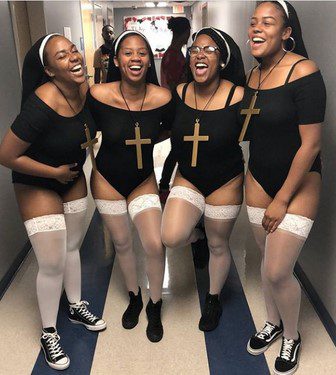
The reason I have dedicated myself to putting together the small book, Christian Fashion in the Teaching of the Church is because I am convinced that a life lived in a Christian way—and consistently so, especially for a woman—is partly expressed by the way one dresses, and that this is particularly important in today’s world. I will try to explain this briefly.
Allow me to present you with an image. In these summer days, not only holiday resorts, but also big cities like Rome or London are invaded by people—men and women—dressed in the most indecent manner. In my opinion, this phenomenon represents a brutal violence against Christians, because it jeopardizes one of the most important but also most fragile virtues of our faith: chastity.
In the streets and squares of large cities, scenes are imposed on passers-by that disturb the eyes, feed curiosity, provoke disordered desires and, in this sense, constitute a real assault. Yet we cannot deny that there is a certain consistency in this indecent attire: it corresponds to the dominant philosophy of life, which is materialism, hedonism and the dissolution of all values. Everything is permitted, and the pursuit of pleasure is the ultimate goal. There is a consistency in this scene.
….
The transition from the Middle Ages to the Renaissance, and humanism, can also be traced in the fashions of those times. Fashion was also the great vehicle to transmit the ideas of the French Revolution.
Fashion made the agitated year of 1968 into a radical turning point in Western social life. The criteria of beauty, decorum, harmony and elegance, which were already in crisis, were overcome by the egalitarian and anarchic spirit which was the very soul of the student movement. In 1968, most of the girls at demonstrations were in trousers. Jeans became a sort of uniform for the youth, the quintessential symbol of the new egalitarian fashion.
….
Along these lines, gender studies developed within American feminism in the seventies. Its advocates placed the denial of an authentic difference between men and women at the center of their conceptual approach. The notion of a fluctuating and subjective identity based on a social construction of gender replaced the objective reality of biological sex.
….
The concept holds that the male—female difference is merely a cultural and not a natural fact. Since culture can change, the next step is to suggest interchangeability in practice. Thus, the medical establishment offers surgical operations to make a man “a woman” and a woman “a man.” To make this utopian idea a normality, it must be imposed in schools, indoctrinating children from an early age.
Clothing is once again a revolutionary tool. In kindergartens and schools where gender ideology is applied, boys dress as girls and girls as boys. Boys can have their nails painted and are being taught embroidery and crocheting, whilst girls devote themselves to disassembling engines or playing with toy cars.
Fashion is therefore a formidable revolutionary weapon and needs to be opposed when it threatens to overthrow the principles of Catholic morality and the core values of Western culture.
….
That such danger is to be found everywhere today is a warning repeated, not only by the Church, but even by men who are outside the Christian faith; the most clear-sighted thinkers, those solicitous for the public good, strongly denounce the sinister threat to the social order and to the future of nations; the poisoning of the roots of life by the present multiplication of incitements to impurity; while the indulgence (which we would do better to call a denial) of an ever-more-extensive part of the public conscience, blind to the most reprehensible moral disorders, slackens the brakes even more.”
….
In the years immediately after the Second Vatican Council, many sought to separate doctrine from the modus—the style or form in which doctrine is expressed. Thus, these people expressed themselves differently from the past and brought about a cultural transformation that is deeper than it may seem. The way in which we presents ourselves—the styles in which we expresses ourselves—reveals a way of being and of thinking.
Fashion is basically a person’s style. Style expresses the ideas which guide us. Through our clothing we express a world vision. If it is true that examples count as much as ideas, then the way we dress also can express our “lived Christianity.”
Virginia Coda Nunziante, Return to Order, The Way Christians Dress Expresses Their Lived Christianity
Bruce Gerencser, 68, lives in rural Northwest Ohio with his wife of 47 years. He and his wife have six grown children and sixteen grandchildren. Bruce pastored Evangelical churches for twenty-five years in Ohio, Texas, and Michigan. Bruce left the ministry in 2005, and in 2008 he left Christianity. Bruce is now a humanist and an atheist.
Your comments are welcome and appreciated. All first-time comments are moderated. Please read the commenting rules before commenting.
You can email Bruce via the Contact Form.
